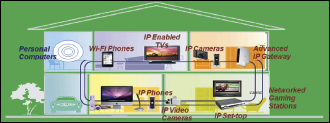HomeNetworking: How To Give Consumers The Ultimate Connected Home
For consumers, the home network is an electronic goody basket overflowing with devices, connections and content. In other words, the more, the merrier.
For cable providers, that same network can seem like a complexity horror house. It was one thing when coax cable snaked its way through a house long ago intent on one thing: delivering a signal to an analog TV.
But today’s home networks come with exponentially more components, connectivity requirements and consumer expectations. Home users happily buy new gadgets and want them to link together seamlessly—including mobile/IP/ Wi-Fi phones, various handheld consumer electronics (CE), HD-enabled IP & 3D TVs, residential gateways, PCs and laptops, set-tops, wireless printers and gaming consoles.
This home networking flexibility and mobility requires consumers to connect their IP devices to local area home network, which brings with it complexities that many consumers are not equipped to address by themselves, whether it’s converged entertainment on three screens (TVs, PCs, mobile), video telephony, social networking or interactive online gaming. Service providers cannot succeed if this complexity is pushed to the customer.
Consumers crave connectivity with integration simplicity, as displayed through recent and forecasted buying habits. U.S. households currently own CE in abundance, including 18.3 million broadband-connected game consoles, 12.4 million PC-to-TV connections, 4.8 million whole-home DVRs and 1.6 million network-attached storage units – numbers that will increase threefold by 2014, according to Parks Associates.
Cable’s advanced HD triple-play service bundles are prime “places” where consumers can satiate their connectivity appetites, creating opportunities for operators to differentiate themselves from their competition – whether through richer services or aftermarket customer-care offerings.
Simplifying the home networking puzzle revolves around delivering to the consumer’s three screens. Nearly a quarter of all smartphone users, for instance, view video on their portable devices at least once a day – a number growing by the day. That means when a consumer starts watching a video on the living room television, he or she may want to finish it in the kitchen via their lap-top or “mobile” devices.
Moving video to different screens via Wi-Fi is becoming a reality as antenna technology and packet reliability improve for home video delivery. In fact, according to ABI Research, by 2014, manufacturers will ship more than 500 million Wi-Fi-enabled handsets.
‘Comfortable’ Standards
When it comes to providing flexibility for their customers, operators will find the most choices and investment comfort from working with vendors that innovate and deliver based on industry standards with a reputation for quality and low total cost of ownership. Operators should be wary of proprietary solutions, which tend to be inefficient and lack the scalability necessary for mass-market deployment.
The right technology choice often depends on whether the in-home LAN services are to be delivered via coax, air or power. Beyond that, operators must consider, among other things, issues like placement (where can the equipment go?), medium (how does the provider connect to the consumer’s in-home devices?), set-up (how is it configured and secured?), quality (how stable is the bit stream?), compatibility (will it work with what is in the home today?) and availability.
Ultimately, cable providers should work with vendors that can remove as much complexity as possible from the home network. In turn, providers need to make home networking as painless and seamless as possible for their customers, who themselves are bringing a multitude of equipment in to the home beyond the operator’s voice, video and data solutions.
Easy use and setup for consumers comes in the form of simple technology like push-button pairing or plug-and-play installation as provided, for example, by the Motorola SBG6580 SURFboard eXtreme Wireless Cable Modem Gateway. According to the manufacturer, this device not only offers a built-in DOCSIS 3.0 8 x 4 modem, an integrated 802.11N wireless access point with commercial grade firewall/security and a 4-port Gigabit Ethernet (10/100/1000) switch, but it also can switch between 2.4 GHz and 5 GHz to avoid interference with radios and microwaves.
And while modems like this can be provisioned by providers, they’re also available at retail establishments, which underscores the need for offering flexibility to expectant consumers.
 |
| FIGURE 1: There is no single standards winner for cable or telco providers when it comes to home networking. Many operators are focused primarily on G.hn, MoCA 2.0, HomePlug and HPNA, though they also should be familiar with 802.11N Wi-Fi standards. All have different speeds, different connection media and different quality. |
Bandwidth ‘Distractions’
While business decisions will revolve around what services will drive the highest average revenue per user, strategists must avoid being distracted by bandwidth. The fastest speed on the block, for instance, won’t hide a lack of security, hard-to-use devices or unreliable service.
In the end, the discussions that matter should revolve around making customers happy and loyal.
Delivering scalable, secure and easy home network solutions are simplified when working with the right partner—a partner that provides solutions to support expansion to new technologies, to reduce management costs, to improve operating efficiencies, to exceed subscriber expectations and to improve customer care.
Ken Haase is senior director/Broadband CPE at Motorola Mobile Devices and Home. Contact him at khaase@motorola.com.